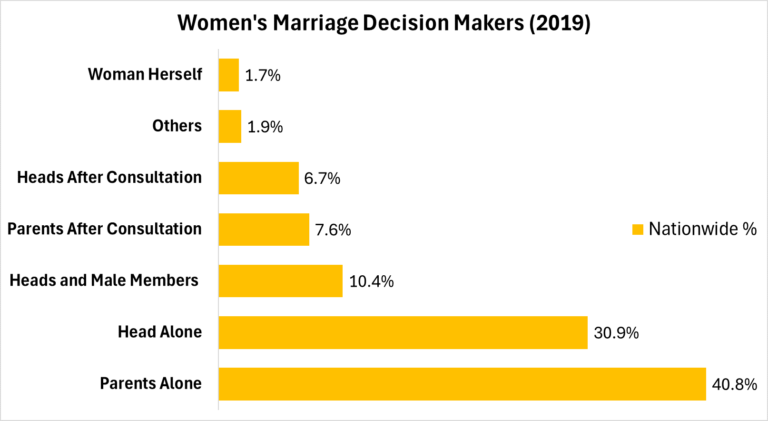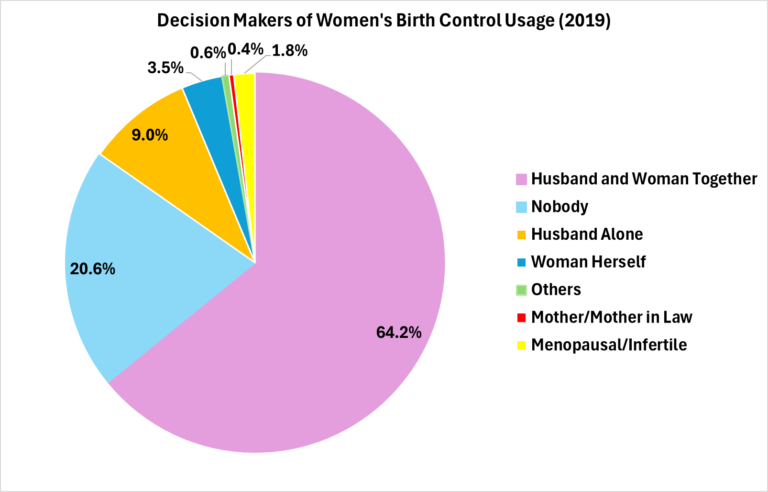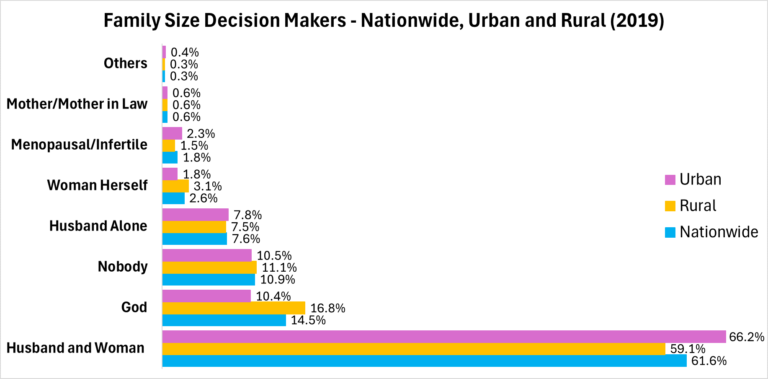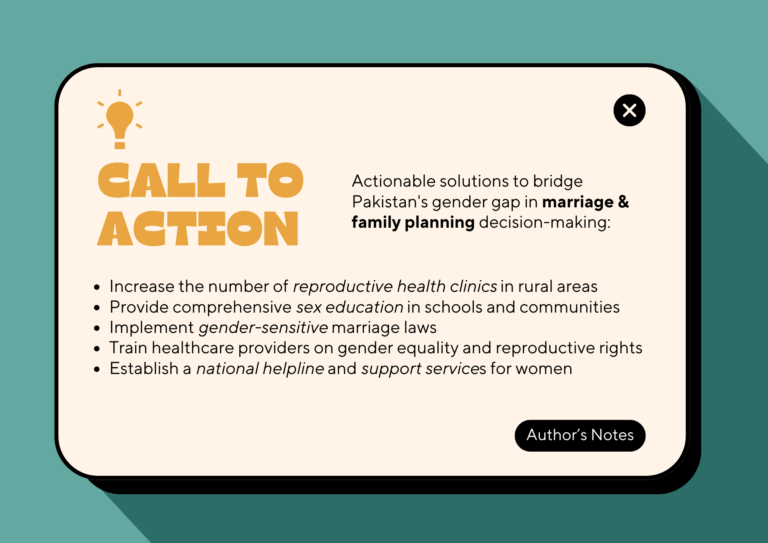Women in Decision Making – Employment
July 19, 2024
Power of AI and HI at Workplace
July 25, 2024This article explores the state of women’s marriage, family planning and birth control usage decision making autonomy in Pakistan (2019). It examines the roles and influences of various parties involved in shaping their choices.
1. Marriage Decisions

Source: PSLM 2018-19
Key Insight 1:
In 2019, a combined 72% of women’s marriage decisions in Pakistan were controlled by parents (40.8%) and household heads (30.9%) alone.
Author’s Analysis:
- These findings reveal a pervasive pattern of patriarchal control,indicating a significant lack of autonomy for women in choosing their own partners. This trend is consistent across most provinces, suggesting a deeply ingrained cultural norm.
- Notably, this dominance of male decision-makers in women’s marriage choices may contribute to Pakistan’s high child marriage rate and low female literacy rate, highlighting the need for policy interventions to empower women’s agency.
- However, there is a shift towards more inclusive decision making, with a decline in heads of households deciding alone (from 41% to 35% in rural areas and from 34% to 24% in urban areas).
Key Insight 2:
Alarmingly, only 1.7% women in Pakistan have autonomous decision-making power over their own marriage, with “other people” having more say (1.9%) than the women themselves.
Author’s Analysis:
- These statistics reveal that a staggering 98.3% of women in Pakistan had no autonomy in deciding their own marriage. Instead, others, including extended family and community members (1.9%), had more influence than the women themselves. This indicates a pervasive patriarchal culture where women’s agency is severely curtailed, and their lives are controlled by others. The data suggests that women’s autonomy in marriage decisions is almost non-existent, highlighting the need for urgent reforms and initiatives to empower women and challenge entrenched gender norms.
Key Insight 3:
In 2019, only 6.7% of household heads and 7.6% of parents consulted the woman before deciding her marriage.
Author’s Analysis:
- This finding reveals a striking lack of consultation and agency for women in Pakistan. This indicates a widespread disregard for women’s preferences, perpetuating a culture of patriarchy and gender inequality. The low consultation rates suggest that women’s voices are often silenced or ignored.
2. Women's Birth Control Usage

Source: PSLM 2018-19
Key Insight 4:
64.2% Pakistani women make joint decisions with their husbands regarding birth control usage, primarily in KPK (69.3%).
Author’s Analysis:
- This joint decision-making leads to improved reproductive health outcomes, enhanced marital relationships, increased female empowerment, and shared responsibility – ultimately contributing to better maternal and child health.
Key Insight 5:
A mere 3.5% women take their birth control usage decision alone, while 9% Men make these decisions for the woman.
Author’s Analysis:
- Men have a considerable influence on women’s reproductive health decisions, with 9% making decisions about women’s birth control usage without their input. This indicates a power imbalance, with men having a disproportionately higher influence over women’s bodies and health choices. This dynamic may perpetuate gender inequality and limit women’s ability to make independent decisions about their own health and well-being.
Key Insight 6:
In 2019, a vast 20.6% of Pakistani women, do not use birth control at all, particularly in rural Baluchistan (48%).
Author’s Analysis:
- These statistics are likely to be a result of deeply ingrained societal stigmas. Often, particularly in conservative and rural communities, the pervasive stigma and shame associated with seeking birth control services discourages women from accessing them.
- Traditional gender roles expect women to prioritize childbearing and family responsibilities over personal choices and autonomy, as evident by 43.5% of women in Pakistan not even seeking employment due to domestic duties.
- Limited education and awareness about family planning and birth control methods in rural areas may be further exacerbating the issue. Cultural and religious beliefs also play a significant role, with some communities viewing birth control as taboo, immoral, or against religious teachings, thereby reinforcing the reluctance to use contraceptives.
Key Insight 7:
Balochistan’s reproductive health crisis: the highest percentage of husbands deciding women’s birth control usage (11%) alone, and the highest percentage of women deciding alone (5.7%), while 48% don’t use any birth control.
Author’s Analysis:
- In Balochistan, only 28.1% of women and their husbands make joint decisions about birth control usage, indicating poor shared responsibility. This lack of understanding and communication is further cemented by Balochistan having the highest percentage of husbands deciding alone (11%) and women deciding alone (5.7%). Additionally, Balochistan has the highest rate of no birth control usage (48%) in Pakistan. All in all, Balochistan is desperately crying for reproductive health support initiatives.
- However, between 2005 and 2019, the percentage of husbands deciding alone decreased by 47% (from 58% to 11%). Despite this decline, the percentage of husbands autonomous say in women’s birth control remains slightly higher than in other provinces. Yet, the significant decline suggests a positive cultural shift.
3. Family Planning

Source: PSLM 2018-19
Key Insight 8:
In 2019, a vast 66% Pakistanis believe that deciding the number of children to have should be a joint decision, 59% in rural areas and 61% in urban.
Author’s Analysis:
- These statistics reflect widespread shared responsibility about family planning. However, 14.5% of women (a whopping 49% of Baluchistan’s population) ‘leave it to God’, effectively relying on religion to relinquish control and planning. Another 10.9% leave family planning to chance, with no one deciding how many children to have. This accounts for about 25.4% of the population which do not actively plan their family size.

The insights in this article suggest progress towards inclusive decision-making, but gender equality in marriage, family planning and reproductive health decision-making remain significant challenges – particularly in rural and conservative provinces.
The data source used in this analysis is the Gallup Pakistan PSLM 2018-19 Data Dashboard, which provides an unparalleled glimpse into the socio-economic trends shaping Pakistan today. For a deeper dive into the data and to uncover more insights, explore the dashboard here.
Author: Maha Gardezi
Reseach and Analytics Intern, Gallup Pakistan
